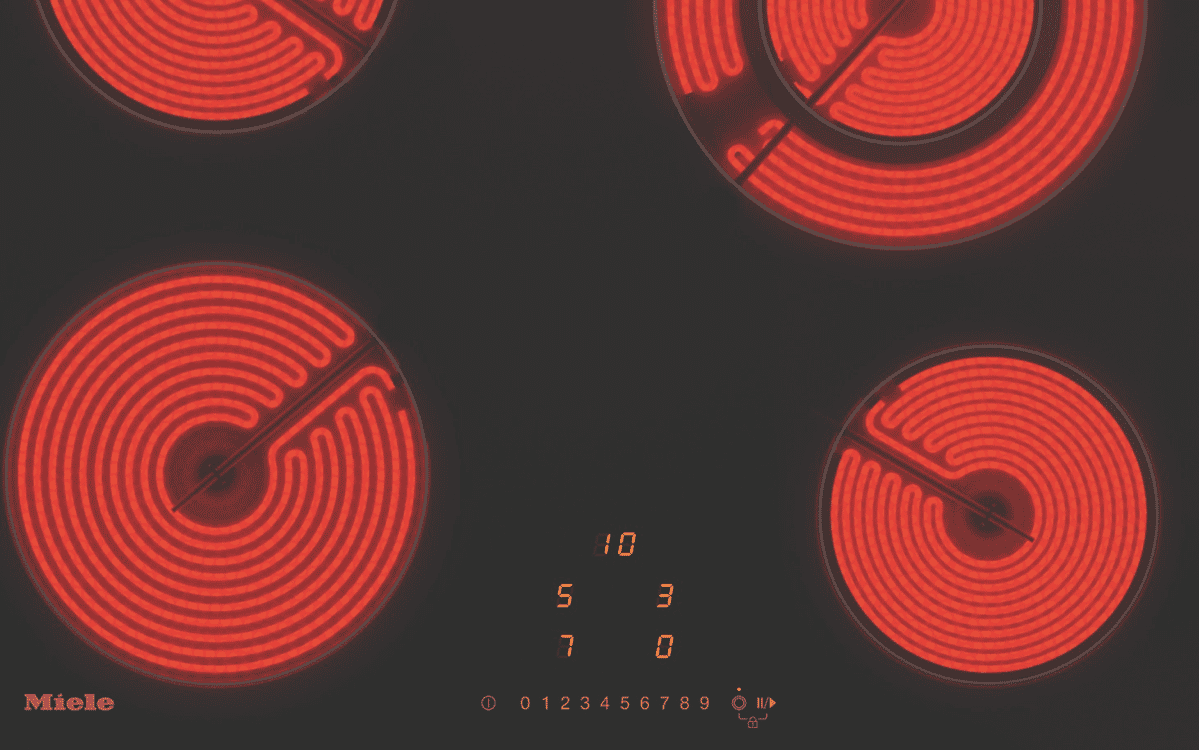Miele KM 6520 FR Electric Cooktop with Onset Controls Installation Guide

Miele KM 6520 FR Electric Cook top with Onset Controls

Installation
Safety instructions for installation
Damage risk from incorrect installation. Incorrect installation can cause damage to the hob. The hob must only be installed by a qualified person.
Risk of electric shock.
Incorrect connection to the mains supply may result in an electric shock. The hob must be connected to the electrical supply by a qualified person only.
Damage from falling objects.
Take care not to damage the hob when fitting wall units or a cooker hood above it. Fit the wall units and the cooker hood before the hob.
- The veneer or laminate coatings of worktops (or adjacent kitchen units) must be treated with 100 °C heat-resistant adhesive which will not dissolve or distort. Any backmoulds must be of heat-resistant material.
- The hob must not be installed over a fridge, fridge-freezer, freezer, dishwasher, washing machine, washer-dryer or tumble dryer.
- After installation, ensure that nothing can come into contact with the connection cable and that it is without hindrance.
- The electrical cable may not come into contact with any moving kitchen component (e.g. a drawer) or be subject to mechanical obstruction which could damage it.
- Observe carefully the safety clearances listed on the following pages.
Safety distances
Safety distance above the hob
The safety distance specified by the manufacturer of the cooker hood must be maintained between the hob and the cooker hood above it.If combustible objects are installed above the hob (e.g., cabinets, utensil rail, etc.), a minimum safety distance of 600 mm must be maintained.When two or more appliances which have different safety distances are installed together below a cooker hood, you should observe the greatest specified safety distance.
Safety distances to the sides and back of the appliance
It is advisable to install the hob with plenty of space either side of it. The minimum distanceshown below must be maintained between the back of the hob and a tall unit or wall.The minimum distance ,shown below must be maintained between a tall unit or a wall to the left or right of the hob with a minimum distance of 300 mm on the opposite side.
- Minimum distance between the back of the worktop cut-out and the rear edge of the worktop: 50 mm
- Minimum distance between the worktop cut-out and a wall or tall unit to the right of it: 70 mm.
- Minimum distance between the worktop cut-out and a wall or tall unit to the left of it: 50 mm.
Interim shelf
It is not necessary to fit an interim shelf underneath the hob but one may be fitted if you wish. If an interim shelf is fitted under the hob, there must be a minimum gap of 110 mm between the top of the worktop and the top of the shelf.A gap of 10 mm should be left at the back of the shelf to accommodate the cable. For hobs with an external mains connection box, this gap must be at least 30 mm.
Safety distance when installing the appliance near a wall with additional niche cladding
A minimum safety distance must be maintained between the worktop cut-out and any niche cladding to protect it from heat damage.If the niche cladding is made from a combustible material (e.g. wood) a minimum safety distance of 50 mm must be maintained between the cut-out and the cladding.If the niche cladding is made from a non-combustible material (e.g. metal, natural stone, ceramic tiles) the minimum safety distance between the cut-out and the cladding will be 50 mm less the thickness of the cladding.
Example: 15 mm niche cladding 50 mm – 15 mm = minimum safety distance of 35 mm
- Masonry
- Niche cladding dimension x = thickness of the niche cladding material
- Worktop
- Worktop cut-out
- Minimum distance to combustible materials 50 mm
non-combustible materials 50 mm – dimension x
Installation notes
Seal between the hob and the worktop
Damage caused by incorrect installation.
Using sealant under the hob could result in damage to the hob and the worktop if the hob ever needs to be removed for servicing.Do not use sealant between the hob and the worktop. The sealing strip under the edge of the hob provides a sufficient seal for the worktop.
Sealing strip
Dismantling the hob for service purposes may damage the sealing strip underneath the edge of the hob.Always replace the sealing strip before reinstalling the hob.
Tiled worktops
Grout lines and the hatched area underneath the hob frame must be smooth and even. If they are not the hob will not sit flush with the worktop and the sealing strip underneath the hob will not provide a good seal between the hob and the worktop.
Installation dimensions – Surface-mounted
All dimensions are given in mm.
KM 6520 FR
- Front
- Mains connection box with mains connection cable
Mains connection cable L = 1.440 mm - c Spring clamps
Surface-mounted installation
Preparing the worktop
- Create the worktop cut-out. Remember to maintain the minimum safety distances (see “Installation –Safety distances”).
Wooden worktops - Seal any cut surfaces on wooden worktops with a special varnish, silicone sealant or resin to prevent the wood from swelling as a result of moisture ingress. The sealant must be heat-resistant.Make sure that the sealant does not come into contact with the top of the worktop.The seal under the appliance ensures that the hob will sit securely in the cut-out without slipping. Any gap between the appliance frame and worktop will become smaller over time.
Secure the spring clamps
The exact positioning of the spring clamps is shown in the individual hob diagrams.
Wooden worktops
- Position the spring clamps on the top edge of the cut-out as shown in the hob illustration.
- Fasten the spring clamps using the 3.5 x 25 mm wood screws supplied with the appliance.
Natural stone worktops
You will need heavy duty double-sided adhesive tape (not included with the hob) to fasten the spring clamps.
- Attach the adhesive tape along the top edge of the cut-out in the positions shown in the hob illustration.
- Position the spring clamps on the top edge of the cut-out and press them firmly into place.
- Coat the side edges and the lower edges of the spring clamps with silicone.
Install the hob
- Feed the mains connection cable for the hob down through the worktop cut-out.
- Position the hob in the worktop cut-out.
- Using both hands, press down evenly on the sides of the hob until it clicks into position. When doing this make sure that the seal of the appliance sits flush with the worktop on all sides. This is important to ensure an effective seal all round.If the seal does not meet the worktop correctly on the corners, the corner radius (≤ R4) can be carefully scribed to suit.Do not use any additional sealant (e.g. silicone) on the hob.
- Connect the hob to the mains.
- Check that the hob works.
The hob can only be removed using a special tool.
Electrical connection
Risk of damage from incorrect connection.
Unauthorised installation, maintenance and repairs can cause considerable danger for the user. Miele cannot be held liable for damage or injury caused by unauthorised installation, maintenance or repair work, or by an inadequate or faulty on-site earthing system (e.g. electric shock).This hob must be connected to the electrical supply by a qualified electrician.The electrician must be familiar with and comply with the national regulations and any additional regulations of the local electricity provider.After installation, ensure that all electrical components are shielded and cannot be accessed by users.
Total power rating
See data plate
Connection data
The connection data is quoted on the data plate. Please ensure these match the household mains supply. Please see wiring diagrams for connection.
Disconnecting devices
It must be possible to disconnect the hob from the mains at all poles using disconnecting devices. A contact distance of at least 3 mm must be observed in the switched-off state. The disconnecting devices are overcurrent protection devices and residual current protection devices.
Disconnecting from the mains
Risk of electric shock.
There is a risk of electric shock if the appliance is connected to the mains supply during repair or service work.After disconnection, ensure the appliance cannot be switched back on by mistake.To disconnect the appliance from the mains power supply, do one of the following depending on installation:
Safety fuses
Completely remove fuses.
Automatic circuit breakers
Press the (red) test button until the middle (black) button springs out.
Built-in circuit breakers
Circuit breakers at least type B or C: Switch the lever from 1 (on) to 0 (off).
Residual current device (RCD)
Switch the main switch from 1 (on) to 0 (off) or press the test button.
Mains connection cable
The hob must be connected to the electrical supply with a special connection cable, type H 05 VV-F (PVC insulated) with a suitable diameter. Please see wiring diagram for connection. See the data plate on the hob for the correct voltage and frequency.
Replacing the mains connection cable
Risk of electric shock. Incorrect connection to the power supply may result in an electric shock.
The mains cable must only be replaced by a qualified electrician.When replacing the mains cable only use cable type H 05 VV-F with a suitable cross section. A suitable connection cable is available from your Miele dealer.
Wiring diagram
Some connection methods are not permitted in all installation locations. Ensure compliance with national regulations and any additional regulations issued by the local electricity provider.